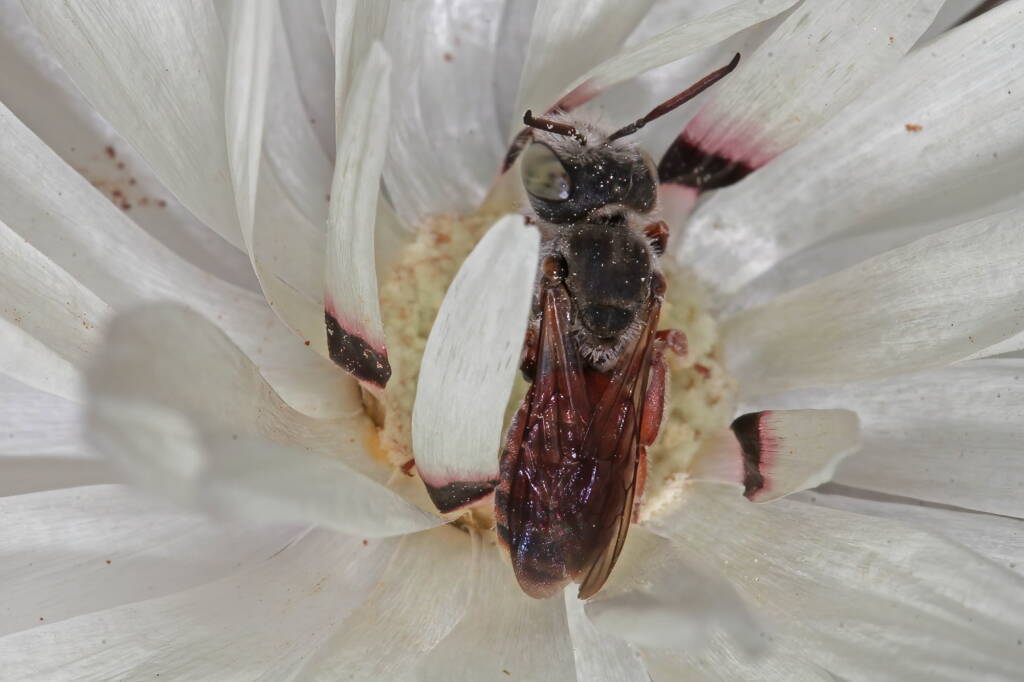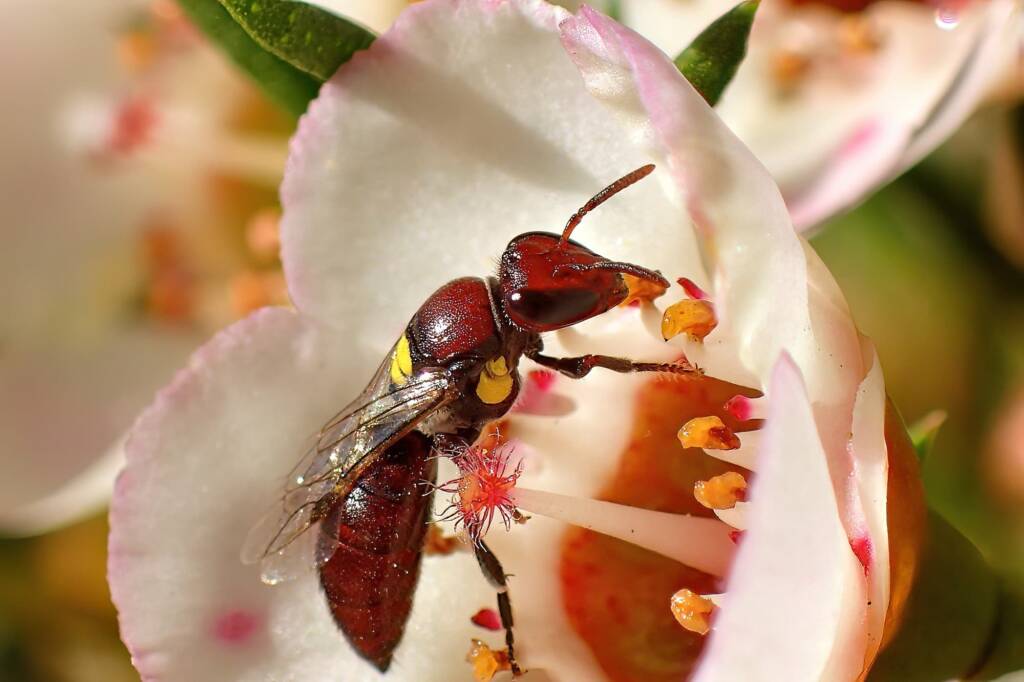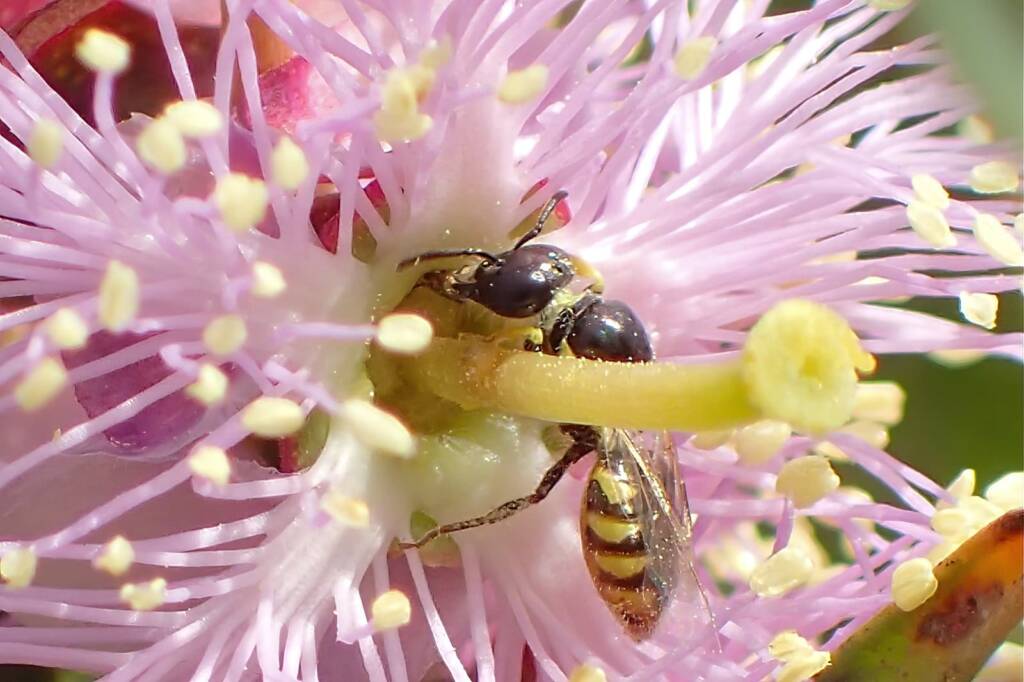ColletidaeAmphylaeus obscuriceps Hylaeus spp – Masked Bee Callomelitta antipodes Leioproctus Neopasiphae mirabilis Paracolletes crassipes Paracolletes nigrocinctus Trichocolletes
Well this paragraph is now obsolete… no-longer correct…
Colletidae only has three sub families, Colletinae, Euryglossinae and Hylaeinae, and has 883 currently identified species (as of a couple years ago) with plenty of others still waiting on being classified and named and 33 genera.
Many thanks to Ken Walker for enlightening us to the change in classification:
The family Colletidae used to have 3 subfamilies : Colletinae, Euryglossinae and Hylaeinae. The new classification for Colletidae now has 5 subfamilies: Callomelittinae (which contains only the genus Callomelitta); Diphaglossinae (which contains only the genus Paracolletes); Euryglossinae (nothing has changed here); Hylaeinae (nothing has changed here; and, Neopasiphaeinae (which contains Anthoglossa, Chrysocolletes, Glossurocolletes, Hesperocolletes, Leioproctus, Neopasiphae, Phenacolletes and Trichocolletes). We suspect that Anthoglossa will move into Diphaglossinae when the nests are found and the larval/pupal cells are examined. I remember I was perplexed when the family Anthophoridae was made a subfamily of Apidae. But, Anthophoridae have scopae while Apidae has corbiculae to carry pollen. However, the decision was made based on the number of ovarioles in the female which is uniquely 4 ovarioles in Apidae/Anthophorinae. Did you notice the endings of the different ranks ? Family names always end in “idae”, subfamily names always end in “inae” and Tribe names always end in ‘ini”. There ends the lecture- Ha!
Source: Ken Walker

Known collectively as plasterer bees or polyester bees, which is due to the method that they use for of smoothing the walls of their nest cells with secretions applied with their mouthparts; these secretions dry into a cellophane-like lining.

Found around the world, with the majority of species living in South America and Australia, with over 50% of all known species living in Australia belonging to the family Colletidae.

The species here in Australia appear to all be solitary bees, although many species do nest in aggregations (clusters or groups).

Two of the subfamilies, Euryglossinae and Hylaeinae, lack the external pollen-carrying apparatus (the scopa) that otherwise characterizes most bees, and instead carry the pollen in their crops. These groups, and most genera in this family, have liquid or semiliquid pollen masses on which the larvae develop.

The Australian genera include Euhesma, a large genus, whose members have been split off into other genera such as Euryglossa and Callohesma.1





- Scientific classification
- Kingdom: Animalia
- Phylum: Arthropoda
- Class: Insecta
- Order: Hymenoptera
- Clade: Anthophila
- Family: Colletidae
- Subfamilies:
- Callomelittinae
— which contains only the genus Callomelitta - Diphaglossinae
— which contains only the genus Paracolletes - Euryglossinae
— nothing has changed, still contain Brachyhesma, Callohesma, Dasyhesma, Euhesma, Euryglossa, Euryglossina, Euryglossula, Heterohesma, Hyphesma, Melittosmithia, Pachyprosopis, Sericogaster, Stenohesma, Tumidihesma, Xanthesma - Hylaeinae
- Neopasiphaeinae
— which contains Anthoglossa, Chrysocolletes, Glossurocolletes, Hesperocolletes, Leioproctus, Neopasiphae, Phenacolletes and Trichocolletes
- Callomelittinae

Footnote & References
- Photographs contribution © Gary Taylor
- Photographs contribution © Marc Newman
- The family Colletidae, Ken Walker, member of Bee Aware of Your Native Bees (Australia), Facebook group, https://www.facebook.com/groups/beeawareofyournativebees/permalink/3513587615548182/
- Colletidae, https://en.wikipedia.org/wiki/Colletidae (last visited Apr. 30, 2022)
ColletidaeAmphylaeus obscuriceps Hylaeus spp – Masked Bee Callomelitta antipodes Leioproctus Neopasiphae mirabilis Paracolletes crassipes Paracolletes nigrocinctus Trichocolletes
BeesBees Anatomy Bee Behaviour Blogging Bees… Bees – image index Amegilla Bee Apis mellifera Austroplebeia australis Austrothurgus Braunsapis sp Ceylalictus perditellus Colletidae Euryglossinae Exoneura Homalictus Hyleoides bivulnerata Lasioglossum Lasioglossum (Chilalictus) Lipotriches Megachile Meroglossa Stenotritidae Tetragonula Thyreus Xylocopa
